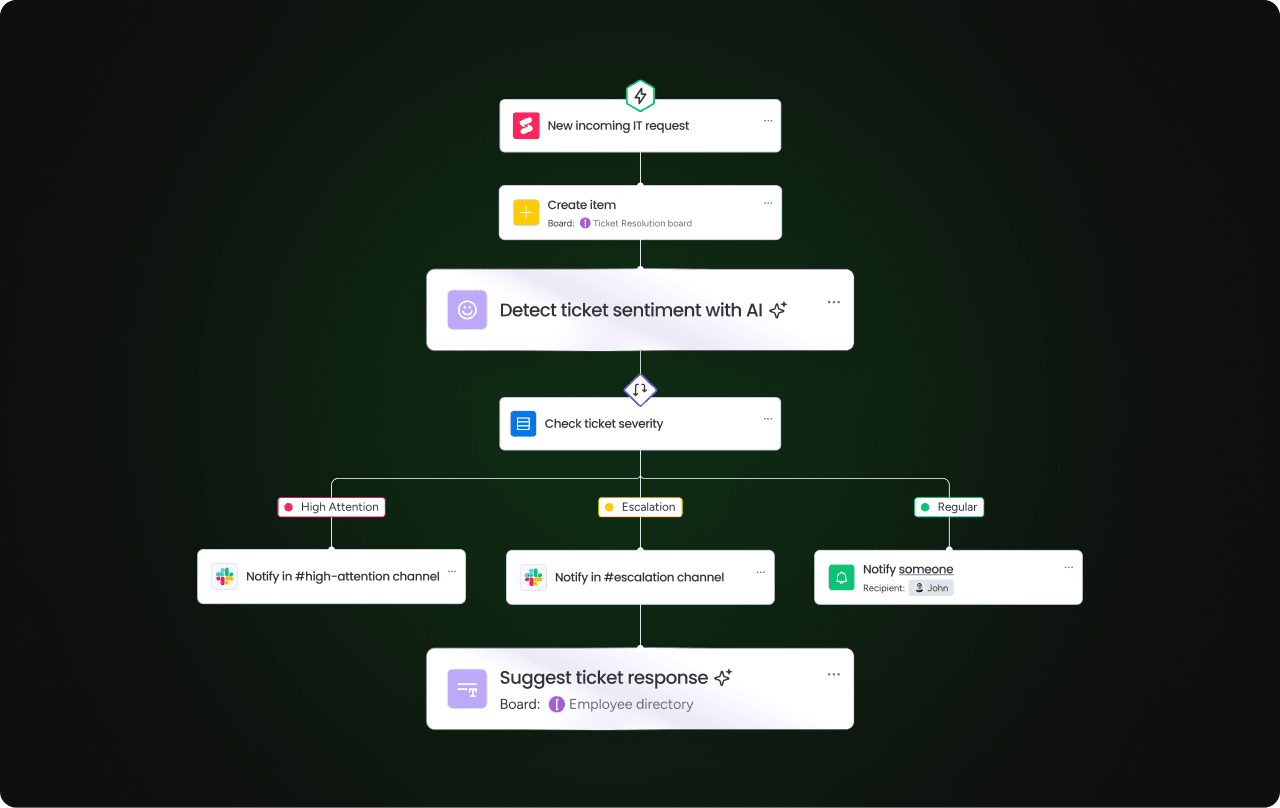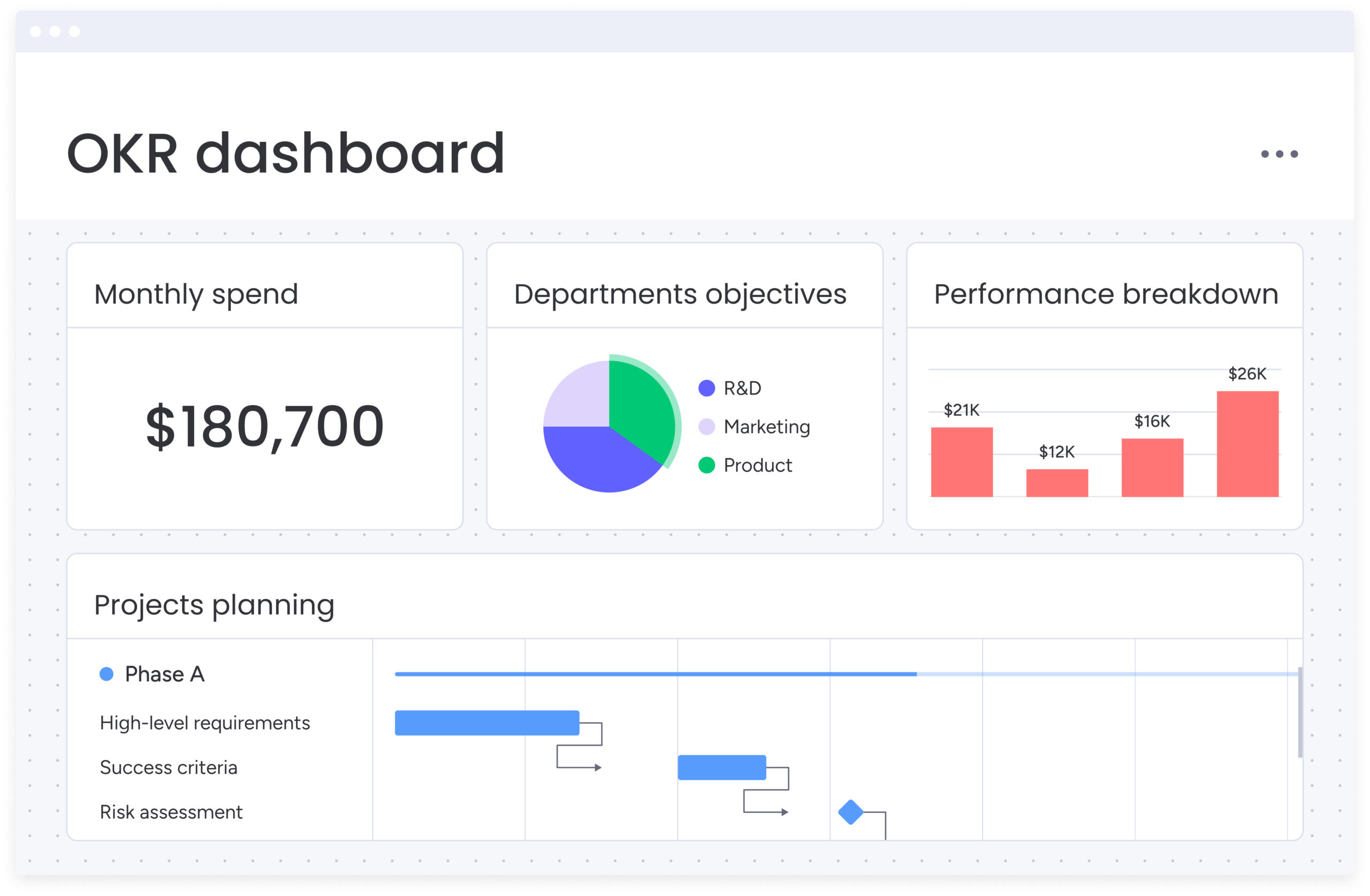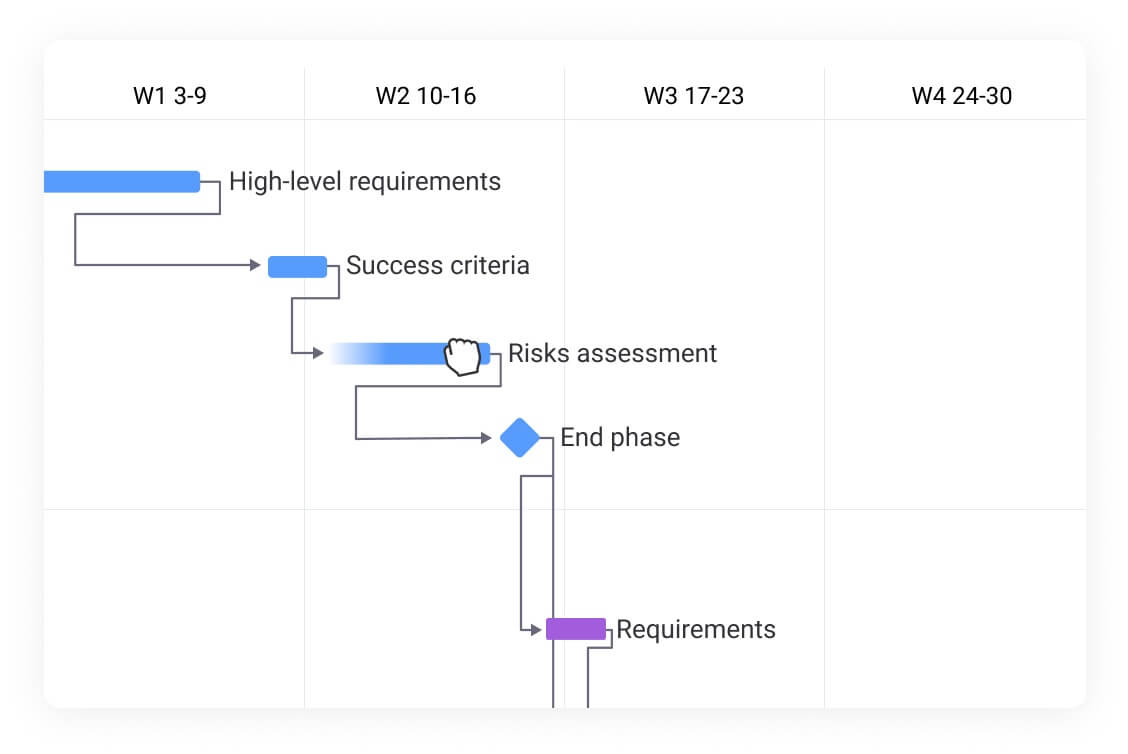Business leaders often have a list of bold, aggressive goals that form the big-picture vision for a company or team. They might want to increase revenue by 50% in 5 years or shift products and practices to become more eco-friendly.
For busy teams, these goals can sometimes feel just out of reach. So how do you move from vision to execution in a way that drives real progress? This is where strategic initiatives come in to create a roadmap that an organization follows to move it closer to its ultimate vision.
These initiatives are implemented to drive incremental change in different areas of a business and can be applied to almost any scenario or department, including marketing, operations, customer service, or supply chain management. By breaking down ambitious goals into bite-sized, actionable efforts, strategic initiatives help teams stay aligned and build momentum over time.
In this article, we’ll look more closely at the steps you can take to plan strategic initiatives, risks to be aware of and how to avoid them, and how AI-powered platforms like monday work management can help you plan and execute any initiative.
Get startedWhat is a strategic initiative?
A strategic initiative is a plan of action that helps an organization or team make progress toward its high-level goals. Strategic initiatives include tangible steps organizations take to help achieve specific outcomes.
Essentially, a strategic initiative is a bridge between a company’s overall goal and the daily activities employed to move the organization closer to the vision and business growth.
To clarify the relationship: a goal defines the broad direction your organization is heading and an objective is a specific, measurable milestone toward that goal. A strategic initiative is a coordinated plan to achieve one or more objectives.
Multiple teams have a hand in executing strategic initiatives, but business leaders often lead them with defined outcomes in mind. A single initiative might include a variety of projects and smaller milestones, so it’s important for leaders to establish a set of key performance indicators (KPIs) to monitor progress.
While strategic initiatives can vary widely in scope and objectives, they usually include specific characteristics, such as:
- Clear goals
- Budgets
- Timelines
- Steps to move initiatives toward the goal
- KPIs to measure progress
A strategic initiative isn’t meant to get you all the way to the ultimate goal; the point is simply to move closer. It’s important to keep that idea in mind as you consider the purpose of each initiative.
What is the purpose of strategic initiatives?
The purpose of strategic initiatives is to identify and execute practical actions that move an organization toward its high-level goals. Each initiative breaks down big-picture objectives into smaller, more achievable projects, helping to reduce overwhelm and provide teams with clear direction. By turning strategy into focused execution, strategic initiatives bridge the gap between planning and results.
The outcome of strategic initiatives will vary from team to team and from one initiative to another. Some may drive revenue growth, while others improve internal efficiency or customer satisfaction. However, business leaders need to be intentional and proactive when defining and managing these initiatives. Well-executed strategic initiatives not only accelerate progress but can also become the key differentiators that set companies apart from their competitors.
Types of strategic initiatives with examples
There’s more than one type of strategic initiative a company can explore. Each one serves a different purpose and can be implemented at different stages of a company’s lifecycle. Here’s a look at the different types of strategic initiatives, along with some examples of how they can be implemented.
Corporate level
Corporate-level strategic initiatives focus on the overall direction and long-term goals of an entire organization. These initiatives often involve major decisions such as mergers, acquisitions, diversification, or entering new markets.
Example: A conglomerate expands into the renewable energy sector to align with global sustainability trends.
Business level
Business level refers to how a specific business competes and succeeds in its market. These strategies focus on gaining a competitive advantage through pricing, product differentiation, or customer focus.
Example: A consumer electronics division launches a premium product line to capture high-end market share.
Functional level
Functional-level initiatives are strategies developed within specific departments like marketing, operations, or HR to support broader business or corporate strategies. These strategies are aimed at improving specific departmental processes to enhance business strategies.
Example: An operations team implements a new inventory management system as part of an operations strategy to reduce waste and improve supply chain efficiency.
Corrective
Corrective initiatives are used to fix existing problems, underperformance, or inefficiencies within the organization. They are often short-term since they’re reactionary but necessary to maintain stability.
Example: A manufacturing company restructures its supply chain after persistent delays and cost overruns.
Constructive or expansive
These initiatives aim to grow or expand the business’s capabilities and reach by improving processes, entering new markets, or increasing capacity. They are typically proactive and growth-oriented.
Example: A software company launches operations in a new international market to tap into global demand.
Innovative or disruptive
Innovative or disruptive initiatives introduce new technologies, business models, or approaches that can significantly alter the company’s position or the industry landscape.
Example: An automotive company invests in building autonomous vehicles to lead the shift toward self-driving cars.
Defensive
Defensive strategic initiatives are designed to protect the company from threats, such as market shifts, competitive pressures, or regulatory changes. They help sustain the company’s position and protect its assets.
Example: A local newspaper launches a digital subscription model in response to declining print revenue and online competition.
What’s the difference between strategy and a strategic initiative?
While the two are closely related, a business’s strategy and strategic initiative aren’t exactly the same. A strategy is the overarching plan or vision that defines where a company wants to go and how it will get there. On the other hand, a strategic initiative is a specific project or action taken to implement that strategy, or a part of it. A strategic management process can help your team take stock of both strategies and initiatives based on your company’s goals. Let’s take a side-by-side look at the differences between the two:
| Aspect | Strategy | Strategic Initiative |
|---|---|---|
| Definition | A high-level plan to achieve long-term goals | A targeted action or project to execute the strategy |
| Scope | Broad and long-term | Focused and short- to medium-term |
| Purpose | Provides direction and competitive edge | Drives progress towards strategic objectives |
| Planning | Conceptual and vision-oriented | Detailed and focused on execution |
| Ownership | Typically led by executives or senior leadership | Involve cross-functional teams or departments |
6 steps for building a successful strategic initiative

A strategic initiative is a significant undertaking that requires both time and resources. To get the most from your investment, take the time to analyze your needs and plan the process. Most organizations will have more than one strategic initiative on their radar, so before jumping into the steps below, make sure to adopt an approach to strategic portfolio management to keep all initiatives streamlined and prioritized.
1. Identify an objective
Analyze the vision and goals in your company’s strategic plan, and choose an objective to pursue. Before you select one, consider both company priorities and your current ability to make progress toward a specific goal.
2. Define an outcome
Identify an outcome that relates directly to your chosen objective. Let’s say that one of your company’s major goals is to be the dominant social media presence in the industry, but your competitors’ current follower counts are twice the size of yours.
Using SMART goals, a strategic initiative might include creating a plan, including a social media campaign focused on brand awareness and customer engagement to increase your following by 25% over one quarter before reassessing strategies for future growth.
3. Establish milestones
Work backward from your desired outcome to lay out project milestones you’ll need to meet along the way. To keep your team motivated, choose milestones that are achievable. Think of them like stepping stones: employees should be able to see how to get to the next milestone, even when the end of the path is out of sight.
4. Create a plan of action
Now that you have a set of milestones, it’s time to create a strategy to achieve each goal.
Identify the people involved, the steps they need to take, and the tactics they can use. It’s helpful to involve team leaders and project managers in this process since they have valuable insight that makes it easier to refine the plan. When the strategy is complete, you can allocate resources based on the scope of each phase.
5. Set KPIs
Before embarking on strategic initiatives, identify the metrics that will help you measure progress toward individual milestones and the final goal. The KPIs you choose should be tailored to specific goals.
If a large company’s initiative is to increase revenue, for example, you could track enterprise KPIs such as average deal size, sales cycle length, and quota attainment. One of your smaller milestones might be to boost sales calls by 30%, so to monitor progress, you can use metrics such as the average length of each call, the number of calls per day, and the number of new leads coming in per day.
6. Analyze and adapt
In business, things rarely go exactly to plan. Unexpected information, discoveries, and other roadblocks can arise at any time. To keep your team on track, get into a habit of regularly monitoring KPIs.
Using the right software, like monday work management, can help you analyze KPIs through reports and dashboards to measure against your timeline and budget and make adjustments as necessary. KPI tracking helps your team spot inefficiencies during a strategic initiative and adapt quickly to keep projects on course.
Get startedBenefits of using strategic initiatives in project management
Strategic initiatives aren’t just task lists; they’re the engines that drive meaningful change within an organization. By turning big-picture goals into focused efforts, they have the power to align teams, allocate resources effectively, and generate measurable impact. Here are some of the key benefits of well-crafted strategic initiatives:
- Clear direction: Break down high-level strategy into small, actionable steps, helping teams focus and understand exactly what needs to be done and why.
- Improved alignment: Ensure that departments and teams are working toward shared objectives, reducing siloed workflows and boosting collaboration.
- Speed up innovation: Provide a structured path to move from strategy to action, accelerating progress and reducing delays.
- Resource alignment: Prioritize and allocate resources, whether it’s time, people, or budgets, more efficiently.
- Risk mitigation: Identify potential obstacles early and take corrective action before small issues grow into larger problems.
- Competitive advantage: Support innovation, efficiency, and responsiveness to make your business stand out in a crowded market.
Practical examples of strategic initiatives
Whether you’re creating strategic initiatives for the entire company or a single team, it’s helpful to consider what you want to achieve. The type of initiative you choose will determine the end goal, milestones, strategies, and KPIs. Below, we’ll look at a few examples of strategic initiatives from different industries. Each outlines a core business objective and the strategic initiatives that support it.
SaaS company
Goal: Improve long-term customer satisfaction and reduce churn
Objective: Increase customer retention by 15% over the next 12 months
Type of initiative: Functional/corrective
Strategic initiatives:
- Launch a customer success program to provide onboarding support, training, and regular check-ins for new users.
- Implement a feedback loop using surveys and in-app analytics to identify friction points and areas for improvement.
- Develop loyalty features such as usage-based rewards or milestone achievements to incentivize continued use.
E-commerce business
Goal: Expand global footprint and diversify revenue streams
Objective: Launch in 3 new European markets and generate 20% of revenue from international sales by year-end
Type of initiative: Business level/constructive
Strategic initiatives:
- Localize the website for key regions, including language translation, currency conversion, and regional SEO optimization.
- Partner with international logistics providers to streamline shipping, returns, and delivery times.
- Launch regional marketing campaigns tailored to local consumer behaviors and preferences to build a region-specific customer experience.
Manufacturing company
Goal: Reduce operating expenses while maintaining product quality and output
Objective: Reduce operational costs by 10% while maintaining customer satisfaction scores above 90%
Type of initiative: Corporate level/defensive
Strategic initiatives:
- Invest in predictive maintenance technology to minimize unplanned downtime and extend equipment lifespan.
- Optimize supply chain processes by digitizing inventory management and improving vendor coordination.
- Implement lean manufacturing practices to eliminate waste and improve production efficiency.
6 reasons strategic initiatives fail and how to avoid them
Even well-designed strategic initiatives can fall short without the right execution. According to the Strategy Management Trends report 2025: The Global State of Strategy report by Quantive, 40% of strategic initiatives don’t succeed. Here are some common pitfalls and a look at what you can do to avoid them.
1. Inadequate planning
When initiatives begin without a solid plan, it’s easy for them to lose direction or stall, especially without clearly defined goals. Taking time to build a clear roadmap with strategic planning that includes defined steps, milestones, objectives, and contingencies can set the foundation for success.
2. Lack of communication
Poor communication creates confusion, misalignment, and misunderstandings across teams. Establish consistent, transparent messaging and open feedback loops with a unified work management and collaboration platform to keep everyone informed and involved.
3. Insufficient monitoring
Without regularly tracking progress and KPIs, problems can go unnoticed until it’s too late to fix. Setting clear KPIs, check-in points, and automating reports with a platform like monday work management helps ensure timely adjustments and steady progress.
4. Uncommitted leadership
When leaders aren’t visibly engaged and transparent, initiatives may lack the momentum and support they need to progress. Buy-in from both leadership and stakeholders is crucial since active involvement builds confidence across teams.
5. Resistance to change
Change can trigger uncertainty, leading teams to resist new initiatives. Proactively address concerns, communicate value, remain open to feedback, and offer ongoing training and support to ease transitions and encourage adoption.
6. Poor resource allocation
Initiatives often fail when teams lack the time, talent, or tools to execute plans effectively. Make sure your resources are aligned with your priorities and stay on top of evolving needs through predictive analytics and forecasting with a solution like monday work management.
Turn strategy into action with monday work management
One of the best ways to make sure your strategic initiatives are well-executed is to monitor every step, from organizing goals to monitoring progress, on a single platform. According to a 2025 report on the State of Strategy Execution, 49% of respondents didn’t have the right tools to effectively measure their strategic plans. With the right tools, your team can easily collaborate, communicate, and keep track of plans, tasks, and assignments in one place. With software like monday work management, teams can work toward strategic initiative objectives without distractions.
As part of the monday.com Work OS, monday work management offers an AI-powered platform that puts automation and ease of use front and center. Users can rely on the platform’s powerful workflow automation tools to cut down on manual tasks and spend more time focusing on executing strategic initiative plans. With an intuitive interface that promotes transparency and collaboration, every team member stays aligned with goals and upcoming tasks that need to be addressed to move strategic initiatives forward.
Below, we’ll take a closer look at some of the main monday work management features for managing strategic initiatives.
Work smarter with AI-powered workflows and automation

Using custom no-code automation and workflows, you can eliminate time-consuming manual updates. Whether it’s sending notifications, assigning tasks, summarizing meetings, or updating statuses, workflows can be set to trigger automatically based on custom rules.
With features like AI Blocks, teams can build modular, reusable AI workflows to automate decision-making, surface insights, and analyze data — all with minimal setup and no code required. The platform’s built-in AI also strengthens workflows with smart recommendations, task prioritization, and risk mitigation.
Jump straight into planning with strategic initiative templates

Featuring a library with hundreds of templates, monday work management makes it easy to get straight into planning your strategic initiatives without delay. You’ll find templates for project roadmaps, goal tracking, business strategy, organizational strategies and plans, and more. These templates come pre-made with columns, automation, and dashboards, so teams can skip setup and dive right into execution, but still easily tailor them to their unique workflows.
Monitor KPIs with AI dashboards and analytics

Strategic initiatives need continuous oversight, and with monday work management’s AI-powered dashboards, you can track key metrics across teams and projects using visual widgets like charts, numbers, timelines, and progress bars. AI agents are also integrated into the solution to offer real-time reports and insights so that you can keep a close eye on KPIs at regular intervals.
Seamlessly collaborate with multiple work views

Coordinating complex initiatives across multiple teams can be challenging, but monday work management’s visual planning tools and drag-and-drop interface make it easier. There are 27 different possible ways to view your work, so each team and department can choose the one that works for them. With the Gantt Chart view, you can map out phases, set dependencies, and manage shifting timelines. The Timeline View gives each team member a clear sense of what’s next and how their work fits into the bigger picture.
Strong strategic initiatives start with strong planning
Successful strategic initiatives require exceptional organization. With strong advanced planning as the foundation of your strategic initiatives, you risk running into roadblocks, misallocating resources, and fumbling communication. With a flexible, reliable, and scalable platform like monday work management, teams can easily plan projects within an initiative while using advanced AI to work smarter by automating repetitive tasks.
Get startedFAQs
What are strategic initiatives?
Strategic initiatives are comprehensive action plans that outline the steps a company needs to take to progress toward a high-level vision or objective. Each initiative includes a variety of smaller goals and milestones that help employees achieve a defined outcome.
How do you develop strategic initiatives?
There are a few key steps teams can follow to develop strategic initiatives, starting with identifying high-priority objectives for your organization. Then, set goals that bring you closer to those objectives. Turn each goal into an initiative by breaking it down into smaller, more accessible milestones, developing a strategy to reach individual milestones, and identifying KPIs to regularly monitor, assess, and improve plans.
How do you evaluate strategic initiatives?
Evaluate strategic initiatives by choosing key performance indicators (KPIs) that measure the results you want to see. Monitor your KPIs over time to determine if teams are making adequate progress. If not, you can adjust the strategy to suit available resources, skills, and time.
What are the key elements of a strategic initiative?
Key elements of a strategic initiative include a clearly defined objective, measurable outcomes (KPIs), a timeline, resource allocation, and a plan of action. These initiatives often align with broader strategic goals and require cross-functional collaboration to succeed.
How do strategic initiatives support business growth?
Strategic initiatives help businesses grow by translating high-level goals into focused, actionable plans. They align resources, break down complex goals into smaller steps, and enable teams to execute efficiently — ultimately accelerating progress and driving measurable results.
What's the difference between a strategic plan and a strategic initiative?
A strategic plan outlines an organization’s long-term vision, goals, and priorities. A strategic initiative is a specific action or project that supports the execution of one or more parts of that strategic plan.
